Teodorescu P.P. Mechanical Systems, Classical Models Volume I: Particle Mechanics
Подождите немного. Документ загружается.


Problems of dynamics of the particle
431
2
0
1
sin
t
et
λ
θωθ μ
μ
−
=−
vanishes at the moment
1
/t πμ
=
(Fig.7.11); then the motion follows the same law,
the particle returning till the point
2
P at a time
2
2/t πμ
=
a.s.o. The oscillations are
isochronic, the period
22
2/ 2/T πμ π ω λ== − (greater than that of the motion in
vacuum) not depending on the amplitudes
0
123
...θθθθ>>>>; we notice also
that
/
0
12132
/ / / ... e
πλ μ
θθ θθ θθ
−
====,
so that the absolute values of the amplitudes form a geometric series of ratio
/
e
πλ μ−
.
Hence, the motion is damped in an infinite time, the particle reaching the lowest
position (stable position of equilibrium).
Figure 7.11. Simple pendulum in a resistent medium.
If, in the case of oscillations of finite amplitude, we consider a resistance
proportional to the square of the velocity (aerodynamic damping), then
22
Rmlkθ=
,
and the equation (7.1.50) becomes
22 2
sin 0kθθωθ++ =
(7.1.53)
for an ascendent motion; in the case of a descendent motion, we replace
2
k by
2
k− .
Noting that
(
)
2
d/d d /2dθθθθ θ θ==
, we may write the equation (7.1.53) in the
form
(
)
2
22 2
d
1
sin
2d
k
θ
θωθ
θ
±=−
,
(7.1.53')
the general integral of which is given by
()
2
2
22 2
4
2
ecos2sin
41
k
Ck
k
θ
ω
θθθ
=+
+
∓
∓
,
(7.1.53'')

MECHANICAL SYSTEMS, CLASSICAL MODELS
432
where
C is a constant which must be determined; the relation (7.1.53'') represents, in
fact, an equation with separate variables, and the quadrature may be calculated for small
amplitudes.
1.3.4 Elliptic pendulum
Let
P be a heavy particle constrained to move on an ellipse of semiaxes a and b of
equation
22
12
22
1
xx
ab
+
= ,
(7.1.54)
situated in a vertical plane, the
1
Ox -axis being the descendent vertical. Using the
parametric representation
1
cosxaq= ,
2
sinxbq
=
, 02q π
≤
< ,
the theorem of kinetic energy
(
)
22
12 1
d/2mx x mgx+=
⎡⎤
⎣⎦
leads to
(
)
(
)
22 2 2 2 2 2
sin cos sin cos sinaqbqqabqqqagq++− =− .
(7.1.55)
In the case of small motions around the point
0
(,0)Pa , which is a stable position of
equilibrium, we have
sinqq
≅
,
cos 1q
≅
,
2
0q
≅
, so that the equation (7.1.55)
becomes
2
0qqω+= ,
2
2
ag
b
ω = ;
(7.1.55')
it results
(
)
00
cosqq ttω
=
− , the motion being periodic, isochronic, of period
2 b
T
ag
π
= .
(7.1.55'')
If
abl==, then one obtains the results in Subsec. 1.3.1, for instance Galileo’s
formula (7.1.45'').
1.3.5 Cycloidal pendulum
Let us consider the motion of a heavy particle
P on a cycloid C with a horizontal
basis, situated in a vertical plane and having the concavity towards the positive
direction of the
2
Ox -axis. The axis
1
Ox is tangent to the cycloid as its lowest point,
while the
2
Ox -axis (an ascendent one) is the symmetry axis of the cycloid (Fig.7.12).
Starting from the definition of the cycloid as a locus (see Chap. 5, Subsec. 1.3.4), we
obtain its parametric equations in the form
1
(sin)xaθθ=+ ,
2
(1 cos )xa θ
=
− ,
[
]
,θππ
∈
− ,
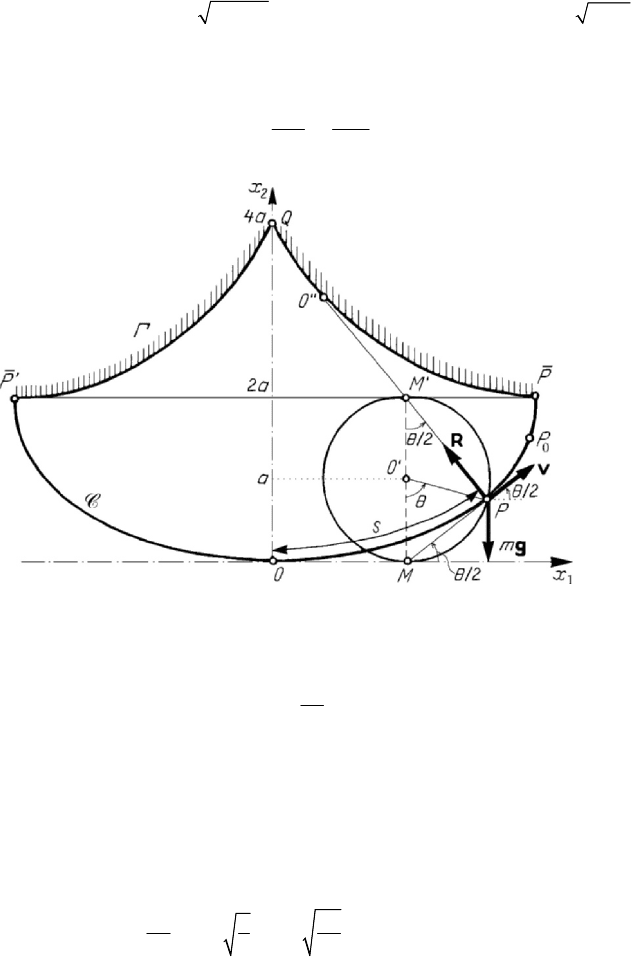
Problems of dynamics of the particle
433
where
2
2xa
=
is the straight line on which the generating circle C (of centre O
′
and
radius
a ) of the cycloid is rolling without sliding. Departing from
222
12
dddsxx=+,
we find
22
d2cos(/2)d 2/dsa axxθθ==; by integration, we obtain
2
22sax=
4sin(/2)a θ= , so that
2
d/d /4xssa
=
. Euler’s equations of motion are written in
the form
2
d
d
x
mv ms F mg
s
τ
===−
,
2
mv
FR
ν
ρ
=
+ ,
Figure 7.12. Cycloidal pendulum.
wherefrom it results
2
0ssω+= ,
2
4
g
a
ω = ;
(7.1.56)
hence,
0
cosss tω
=
, (7.1.56')
assuming that the particle is launched without initial velocity from the point
0
P , of
curvilinear co-ordinate
0
s , at the initial moment
0
t . The period of the motion is
24
42
aa
T
gg
π
ππ
ω
== = ;
(7.1.56'')
this period does not depend on the amplitude
0
s , so that the oscillations are isochronic
(independent of their magnitude). On the other hand, a particle in a free fall from the

MECHANICAL SYSTEMS, CLASSICAL MODELS
434
point
0
P reaches the point O (the lowest point of the cycloid) in the time /4T , which
is independent of
0
s , hence of the initial position; this is the property of tautochronism
of the cycloid. We say that the motion is tautochronous, independent of the magnitude
of the oscillations, the cycloid being thus a tautochronous curve. This property has been
put in evidence by Huygens, which realized a cycloidal pendulum with the aid of the
evolute of a cycloid, that one being a cycloid too. The thread by which is connected the
particle
P (unilateral constraint) is fixed at the point
Q
(cuspidal point of a cycloid
concretely built up); but the resistances which intervene modify considerable the
motion.
Taking into account the theorem of the kinetic energy, we may write
(
)
20
22
2vgxx=−, where the ordinate
0
2
x corresponds to the initial position
0
P .
Noting that
2
1
d (1 cos )d 2 cos d cos d
22
xa a s
θθ
θθ θ
=+ = = ,
we have
1
d/d cos(/2)Fmgxsmg
ν
θ=− =− ; because 2PO PMρ
′′ ′
==
4cos(/2)a θ= , the second equation of Euler gives the constraint force
0
cos cos
cos
2
2cos
2
Rmg
θθ
θ
θ
⎛⎞
−
⎜⎟
=+
⎜⎟
⎜⎟
⎝⎠
.
(7.1.57)
If, in particular,
0
θπ=± , hence if the particle travels through the cycloid without
initial velocity, from one of the cuspidal points
P or P
′
, then it results
2cos 2
2
Rmg F
ν
θ
==−
;
(7.1.57')
in this case, we can state, after Euler, that the modulus of the constraint force is the
double of the modulus of the normal component of the own weight of the particle.
1.3.6 Motion of a heavy particle on a surface of rotation
Let us consider the motion of a heavy particle
P on a surface of rotation, the axis of
rotation of which is vertical (Fig.7.13). The own weight
mg of the particle and the
constraint force
R (the support of which pierces the
3
Ox -axis) act in the meridian
plane, their moments with respect to the symmetry axis vanishing; hence, we may write
the first integral of areas for the projection
P
′
of the particle P on the plane
12
Ox x ,
hence also for the particle
P , in the form (we use cylindrical co-ordinates)
22
00
rr Cθθ
=
=
,
(7.1.58)
where
(
)
00
rrt
=
,
()
00
tθθ=
. Because the constraint is scleronomic and the given
force is conservative, we may use also the first integral of energy
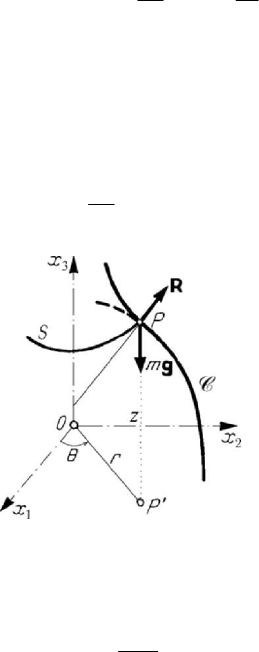
Problems of dynamics of the particle
435
()
222222
00
2vrr zv gzzθ=+ +=+ −
,
(7.1.58')
where
(
)
00
zzt
=
,
(
)
00
vvt= .
If the surface of rotation is given by
()rfz
=
(the equation of the meridian curve
C), then we may eliminate the functions ()rrt
=
and ()tθθ
=
between the equations
(7.1.58), (7.1.58'), obtaining the equation with separable variables
()
()
2
222
00
2
12
C
zfvgzz
f
′
+=+ −−
,
d
d
f
f
z
′
= ,
(7.1.59)
which determines the applicate
()zzt
=
by a quadrature; returning to the equation of
the surface of rotation and to the first integral of areas, we obtain the other co-ordinates
of the point
P . In the case of a circular cylinder of radius l , the equation (7.1.59)
becomes (
f
l= )
()
2
22
00 0
2
2
C
zv gzz
l
=+ −−
,
constC
=
,
(7.1.59')
Figure 7.13. Motion of a heavy particle on a surface of rotation.
in the case of a circular cone of equation
rkz
=
, constk
=
, we may write
()
()
2
22 2
00
22
12
C
kz v gz z
kz
+=+−− , constC
=
,
(7.1.59'')
while in the case of a sphere of radius
l we obtain (
222
rzl
+
= )
()
(
)
22 2 2 2 2
00
2lz v g z z l z C=+ − −−
⎡⎤
⎣⎦
, constC
=
.
(7.1.59''')
If we represent the surface of rotation by the equation
()zrϕ
=
, we may eliminate
the functions
()zzt= and ()tθθ
=
; it results the equation
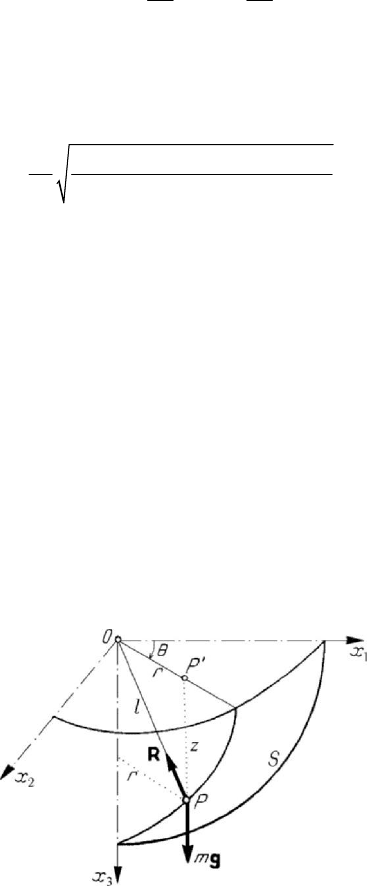
MECHANICAL SYSTEMS, CLASSICAL MODELS
436
()
()
2
222
00
2
12
C
rvgz
r
ϕϕ
′
+=+ −−
,
d
d
r
ϕ
ϕ
′
=
,
constC
=
,
(7.1.60)
which specifies the radius
()rrt
=
by a quadrature too.
Eliminating the time, we obtain the equation of the trajectory of the point
P
′
in the
form
[]
[]
{}
0
2
0
222
00
1()
d
2()
r
r
C
vgz C
ϕρ
ρ
θθ
ρ
ϕρ ρ
′
+
=+
+− −
∫
,
(7.1.61)
where
00
()tθθ
=
; assuming that the surface is algebraic, Kobb has put in evidence the
cases in which the function
()rθθ
=
is expressed by means of elliptic functions.
In the case of a conservative force, the potential of which depends only on
r , the
problem may be solved only by quadratures too.
1.3.7 Spherical pendulum
A heavy particle which moves frictionless on a sphere of radius
l is called spherical
pendulum. The constraint may be bilateral or unilateral; in what follows we consider the
case of a bilateral constraint. We choose the equatorial plane of the sphere as plane
12
Ox x , the axis
3
Ox being along the descendent vertical; further it is convenient to use
cylindrical co-ordinates (Fig.7.14). If the constant
C of the first integral of areas
(7.1.58) vanishes, then
0θ
=
, hence constθ
=
; the trajectory of the particle is
contained in a meridian plane of the sphere, being thus a great circle of it. The spherical
pendulum is, in this case, a simple pendulum. If the constant
C is non-zero, then we
have to do with a non-degenerate spherical pendulum.
Figure 7.14. Spherical pendulum.
The equation (7.1.59''') becomes
22
()lz Pz= ,
()
(
)
2222
00
() 2Pz v g z z l z C=+ − −−
⎡⎤
⎣⎦
,
(7.1.62)
so that
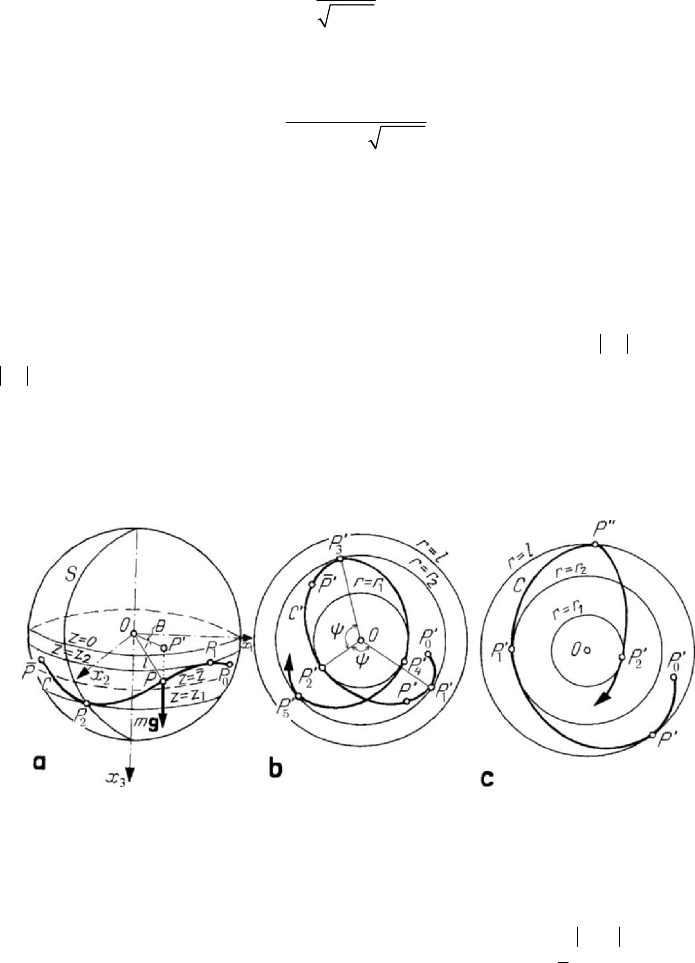
Problems of dynamics of the particle
437
0
0
d
()
z
z
tt l
P
ζ
ζ
=±
∫
;
(7.1.63)
the first integral (7.1.58) allows to determine the angle
θ in the form
()
0
0
22
d
()
z
z
Cl
lP
ζ
θθ
ζζ
=±
−
∫
.
(7.1.63')
In the two above formulae one takes the sign of
(
)
00
zzt
=
, assuming that 0z ≠ . If
0
0z = , then one takes into account the increasing or decreasing of z , starting from
the initial value
0
z .
First of all, we assume that
0
0z
≠
; in this case
0
() 0Pz > (from (7.1.58), (7.1.58'),
(7.1.62) it results
(
)
22 2
0000
()Pz r r z=+). However, during the motion one must have
() 0Pz ≥ so that the integrals (7.1.63), (7.1.63') be real. Noting that
0
zl< (for
0
zl= we have the simple pendulum) and that ()P
−
∞=∞,
2
()Pl C±=− , it
results that the polynomial
()Pz is of the form
123
( ) 2 ( )( )( )Pz gz z z z z z
=
−− − −,
0
321
zlzzzl
−
∞< <− < < < <
.
(7.1.64)
Figure 7.15. Spherical pendulum: zone of oscillation on the sphere (a); projection of the
motion on the equatorial plane: case
2
0z > (b); case
2
0z
<
(c).
Hence, the particle
P oscillates on the spherical zone contained between the parallel
circles specified by
1
zz= and
2
zz
=
(to have () 0Pz ≥ ) (Fig.7.15,a). Viète’s
formula allows to write
(
)
2
31 2 12
()zz z l zz+=−+ ; noting that
2
12
zz l< and
3
0z <
, it results that
12
0zz
+
>
. Hence, the parallel
12
()/2zz z z
=
=+ ,
equidistant to the parallels
1
zz
=
and
2
zz
=
, is always situated under the equatorial
circle (in the austral hemisphere). Departing from
0
P
, let us suppose that z decreases
(we have the sign – before the radical); the particle reaches
1
P
on the parallel
2
zz= ,
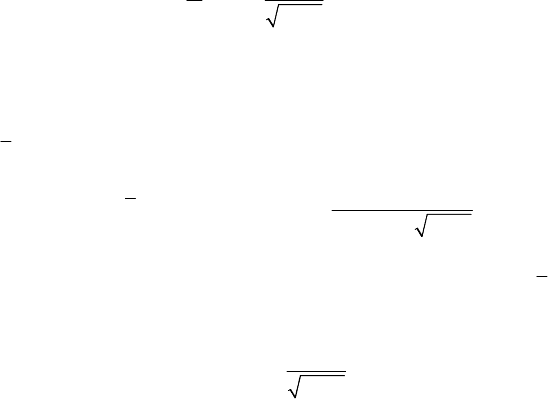
MECHANICAL SYSTEMS, CLASSICAL MODELS
438
where the trajectory has a horizontal tangent (at this point
0z
=
, but 0θ ≠
). Then,
the particle rotates about the vertical axis
3
Ox and reaches the point
2
P on the parallel
1
zz= , where the tangent to the trajectory is horizontal too; further, the particle reaches
the point
3
P on
2
zz= a.s.o. The particle P travels through the arc of trajectory
12
PP
in the interval of time
1
2
d
2
()
z
z
Tz
l
Pz
=
∫
;
(7.1.65)
the same interval of time is necessary to travel through the arcs
23
PP ,
34
PP a.s.o. We
notice that the meridian planes of the points of contact of the trajectory with the
extreme parallels are planes of symmetry of this trajectory; indeed, for two points
P
and
P
of the same parallel z we have
()
1
22
22
d
()
z
z
Cl
lP
ζ
θθ θ θ
ζζ
−=−=
−
∫
.
The necessary intervals of time to travel through the arcs
2
PP and
2
PP are equal too,
being given by
1
d
()
z
z
l
P
ζ
ζ
∫
.
We observe that after a time
T we find again the same values for z and z .
If
0
0z
=
, then we have
0
() 0Pz
=
too. Assuming that
0
()/2Pz
′
22
000
0gr z v=− ≠, the particle is launched from one of the extreme parallels (we have
0
1
zz= or
0
2
zz= ) with a horizontal initial velocity (hence, tangent to the respective
parallel); in the case of the parallel
2
zz
=
one takes the sign + before the radical, while
if one departs from the parallel
1
zz
=
the sign – is used. If
0
() 0Pz
′
= , then the
equation
() 0Pz = has a double root
22
000
12
/zzzgrv=== and one may write
22 2
03
2( )( )lz gz z z z=− − −
; noting that
3
zz> , one can have the latter relation
only for
0
constzz
=
=
. The trajectory of the particle is the parallel
0
zz= situated
in the austral hemisphere, because
0
0z >
. The spherical pendulum is reduced – in this
case – to a circular conical pendulum.
From (7.1.58), we notice that
θ
has a constant sign; it results that the point P
′
(the
projection of the particle
P on the equatorial plane) rotates permanently in the same
direction around the centre
O , that direction being specified by the sign of the angular
velocity
θ
, hence by the sign of C (if 0C > , then 0θ > too). The projection of the
trajectory
C of the particle P on the equatorial plane is the trajectory C
′
of the
projection
P
′
. If
2
0z ≥ , then the trajectory of this projection is contained between the

Problems of dynamics of the particle
439
concentric circles
22
11
rr l z== −,
22
22
rr l z== −,
12
rr
<
, without any point
of inflection (Fig.7.15,b); the projection
P
′
gives the impression that it describes an
oval which is rotating in the direction of the motion (always in the same direction). One
can show that
12 23
...POP POP
′′ ′′
==
; Puiseux proved that these angles are always
greater than
/2π , while Halphen and then Saint-Germain showed that they are at the
most equal to
π . The angle
5
112
4POP POP
′
′′′
=
is the angle of precession and
emphasizes the “delay” of the point
5
P
′
with respect to the point
1
P
′
, so that the
trajectory of the point
P
′
cannot be closed. If
2
0z
<
, then the corresponding parallel
is above the equatorial circle, but we have still
12
rr
<
(because
12
0zz+>); the
trajectory of the projection
P
′
is tangent to the equatorial circle, and we may have also
inflection points. The properties which have been mentioned before are maintained
(Fig.7.15,c).
With the aid of the substitution
2
112
()zz z zu=− − and of the notation
2
12
()kzz=−
13
/( )zz− 1
<
,
13
2/ ( )lgzzτ =−, we may write the formula
(7.1.63) in the form
()()
0
222
0
d
11
u
u
tt
uku
τ
=±
−−
∫
,
(7.1.66)
wherefrom (we take
0
0t = and the sign + before the integral)
sn
t
u
τ
= ,
2
112
()sn
t
zz z z
τ
=− − ;
(7.1.66')
hence, z is a doubly periodic function of
t
. The angular velocity ()tθ
is obtained as a
rational function of
sn( / )t τ ; one can integrate by decomposing in simple elements,
using Hermite’s method, obtaining thus the function
()tθ , which is not uniform. But
Tissot and then Hermite have state how to obtain the co-ordinates
1
z and
2
z as uniform
functions of
t
. Greenhill showed that, in the case in which the point
0
P
is in the plane
0z =
, the initial velocity being tangent to the equatorial circle, then
θ
and
t
are
given by pseudoelliptic integrals, which may be expressed by elementary functions.
The constraint force
R (Fig.7.14) is given by
2
/
nn
RFmvρ=− +
; noting that
n
lρ = and /
n
Fmzl=− , we get
2
00
(3 2 )
m
Rvgzz
l
=+−
⎡
⎤
⎣
⎦
.
(7.1.67)
The force
R
is directed towards the centre
O
( 0R > for
0z >
) if the particle is in
the austral hemisphere; if
P is in the boreal hemisphere (
2
0z
<
), then it is possible to
have
0R = for a parallel z . In the case of a unilateral constraint (the particle is at the
extremity of a perfectly flexible and inextensible thread), after passing the parallel

MECHANICAL SYSTEMS, CLASSICAL MODELS
440
zz=
, the particle may move further on an osculating parabola to the previous
trajectory on the sphere, in a vertical plane, till it meets again the sphere; then, the
motion is continued in conformity with the laws established before. In the case of a
bilateral constraint, the constraint force may change its sign, being directed towards the
interior of the sphere. We notice that, in general, the resultant of the forces
R and mg
is tangent to the trajectory at the point
P , hence it is contained in the osculating plane
to the curve at that point. If
=
R0, then the osculating plane is vertical; in this case,
the trajectory of the projection
P
′
on the equatorial plane has an inflection point at this
point. In the case of the circular conical pendulum, the constraint force becomes
22
000
//Rmglz mlvr== ; the projection of this force on the equatorial plane is
22
00000
//Rr l mv r mr θ==
, hence a centripetal force.
Projecting the equation of motion on the Cartesian co-ordinate axes, we obtain
1
1
x
mx R
l
=−
,
2
2
x
mx R
l
=−
,
3
3
x
mx mg R
l
=−
;
in the case of small oscillations around the position
12
0xx
=
=
,
3
xl=
, which is a
stable position of equilibrium, we notice that
()
22
12
222
312
2
1 ...
2
xx
xlxxl
l
+
⎛⎞
=−+=− +
⎜⎟
⎝⎠
.
In a first approximation
3
xl
=
(we neglect the second term with respect to unity), and
we may assume that the motion takes place in the plane tangent at the lowest point of
the sphere. In this case, the third equation of motion leads to
Rmg
=
; the first two
equations may be written vectorially in the form
g
l
+
=
rr0
,
(7.1.68)
where
r is the vector radius in the equatorial plane. One obtains thus an elliptic
oscillator, which will be studied in Chap. 8, Subsec. 2.1.1. The motion is periodic and
the trajectory is an ellipse, which may be travelled through in an interval of time given
by
2/Tlgπ= (the period corresponding to a simple pendulum). An approximation
of second order has been considered by Tisserand; other methods of approximation
have been used by Resal and Sparre.
2. Other problems of dynamics of the particle
After considering the problems of Abel and Puiseux and of tautochronous motions,
one deals with the motion on a brachistochrone or on a geodesic curve, as well as with
other cases of motion. Some results concerning the stability of the equilibrium of a
particle are given too.
